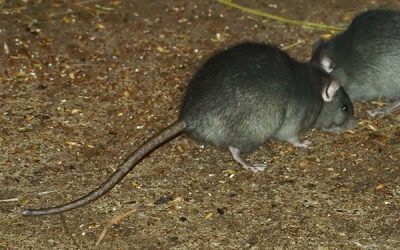Rodents

Commensal (domestic) rodents live in close association with humans. These commensal rodents are nocturnal and tend to move indoors to warmer areas during late fall or early winter and return to the outdoors in late spring or early summer, or remain indoors if food and suitable harborage are available. Mice and rats are a problem when they find their way into your home. They like to be near humans so that they have a ready supply of food. This has earned them the term “commensal,” which means “to share one’s table.”
Removing rodents can sometimes be as easy as setting a mouse trap; but a larger infestation (especially with rats or larger rodents) can be larger issue. Rats, especially, are smart and can learn to avoid traps.
Rodents can carry up to thirty-five diseases that humans are susceptible to, which is another reason to eliminate them as soon as possible. Cleaning up after a rodent infestation also requires a great deal of caution. This is necessary because of the possibility of fleas or mosquitoes, which may transmit their own diseases to you, your children and pets. There is also risk involved if you inadvertently stir up the dust of their nests; it can be hazardous to breathe in the bacteria contained within.
Rodents can also do physical damage your home or business. They easily chew through some types of siding and other building materials. They are also known to chew on electrical lines, thereby increasing the possibility of fire. They damage other materials as well, creating holes and gnawing on numerous objects, especially food or food containers.
Removing rodents can be difficult. A professional pest management company will identify nesting areas and feeding grounds and know how to completely eliminate them. Proper cleanup is also performed, ensuring that you and your family are safe from allergies, illness and possible future infestation.
Commensal Rodents
Commensal rodents generally have poor sense of vision, but they have acute sense of smell, touch, and taste. They tend to gnaw through any material that is softer than their enamel, and they are generally good climbers, jumpers, swimmers and burrowers. There are three species of domestic rodents:

Roof Rat
Rattus rattus, alias: Black Rat/Tree Rat – Roof rat is slender and agile, and Its tail is longer than the head and body lengths combined. Its total length may reach 12 to 17 ¾ inches and can weigh up to about ¾ of a pound. Roof rat nests above ground and lives in ivy, wild blackberry vines, attics, garages, and wood piles. It will enter buildings if given the opportunity, and often use utility lines and fences as runways. It prefers to feed on fruits, nuts, ivy, and pet food commonly found in residential areas.

Norway Rat
Rattus norvegicus, alias: Sewer Rat/Wharf Rat – Norway rat is larger and more aggressive than the roof rat. It has smaller eyes and ears than the roof rat, and its tail is shorter than the combined head and body length. Its total length may reach 18 inches and may weighs up to about 1 lb. Norway rat lives and nests in underground burrow system and is generally found in agricultural areas, creeks, sewers and occasionally developed neighborhoods. It can also live in buildings, basement, creekbanks, waterfronts, under blackberry vines, under wood piles. It feeds on garbage, pet food, meat scraps, cereal grains, fruits and vegetables.

House Mouse
Mus musculus – House mouse is small, slender bodied, and the tail is longer than the length of its head and body. Its body size ranges from 2-1/2 to 3-4/5 inches long. Its body color is generally grayish brown with a gray or buff belly. House mice is agile climbers and can fit through openings as small as ¼ inches in diameter. It eats many types of food, but prefers seeds and grain. It normally travels an area averaging 10 to 30 ft. in diameters.
